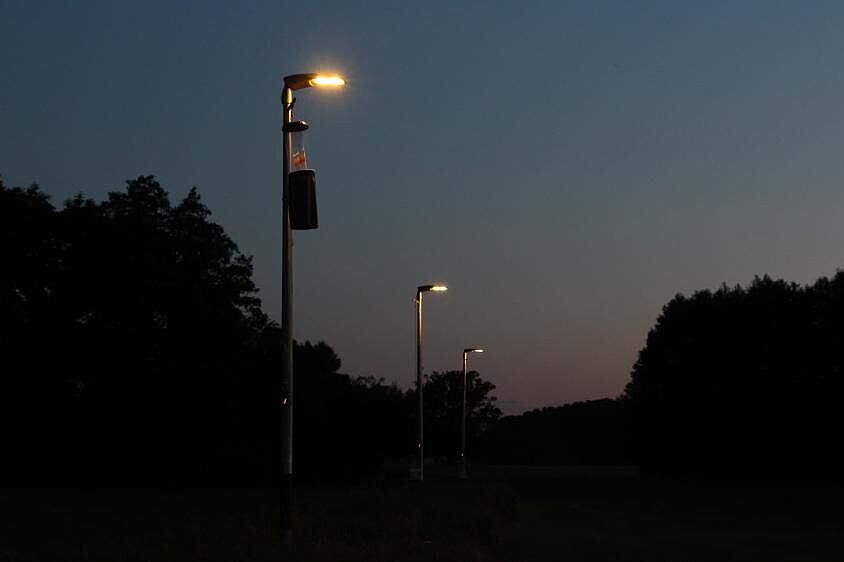From 5 to 12 April 2021 is the International Dark Sky Week. The event always takes place during the week of the new moon in April, when the sky is dark and visibility of the night sky is optimal. Researchers and amateur astronomers want to remind people of the fascination of the night and draw attention to the issue of light pollution. Too much artificial light at night not only makes the stars invisible; it can also disturb humans and animals. Researchers from IGB are studying the effects of artificial light on insects.
With their research on the protection of the little six-legged creatures, Dr Sibylle Schroer and Johanna Reinhard want to achieve one thing: "More benevolent Ohhhh, less disparaging Ehhhh". And another wish is even more important to them: "More darkness, less artificial light." The IGB researchers are coordinating the project "Species protection through environmentally friendly lighting". Researchers in ecology and lighting technology, together with citizens in three project areas in Germany, are investigating and testing new concepts for adapting artificial light at night to the needs of humans and animals.
Not only moths – half of all insect species are nocturnal
Participants of the insect monitoring install traps on lamps and evaluate the findings. Insect species are identified and counted in workshops. What the researchers find in the traps is neither colourful nor eyecatching and therefore little known: the hummingbird hawk-moth, the silver Y or the Scarlet tiger moth, to name just a few moth species. "However, we should not overlook them, because more than 3,300 moth species and thus more than 95 percent of the native butterfly species belong to the group of nocturnal insects. They are important pollinators and play a significant role in the food web," explains Johanna Reinhard.
About half of all insect species are nocturnal. They rely on darkness and natural light from the moon and stars to navigate, or to avoid predators. Natural night light conditions are also important for the insects to forage for food and reproduce - with these all night tasks they fulfill important ecosystem services such as pollination and food supply for other animals and consequently for our quality in life. An artificially illuminated night disrupts this natural behaviour – and reduces the chances of survival.
Flying insects in particular are attracted to lamps, skybeamers and neon signs and then die there through exhaustion, or as easy prey for predators. The light sources act like a hoover in the ecosystem: a previous study by the IGB on an experimental field in the Westhavelland in Germany, for example, showed that up to 260 times as many insects buzz around illuminated street lamps as in the dark surroundings. In only one night over 5000 individuals were captured at a single street light.
Light pollution: one of the causes of insect mortality
Therefore, light pollution could be an important reason for the worldwide decline of insects, states Dr. Gregor Kalinkat of the IGB: "The global 'insect die-off' – in the form of species and population declines – is one of the most pressing problems in biology and environmental science, with possible consequences for food production, to name just one example. We suspect that artificial light at night is a major reason for this negative trend, which is well documented, especially in Germany."
Unfortunately, there have been almost no studies to date that have investigated the connection between insect mortality and light pollution in the long term, i.e. beyond one or two years. Gregor Kalinkat and a team of IGB researchers and members of Dutch Butterfly Conservation have just published a study on the existing data. The authors present a checklist of key points that should be considered in future experiments.
For meaningful insect monitoring, the area and the timing should be chosen as broadly as possible to capture natural fluctuations in insect populations. Various trap types and trapping methods should be used to capture the highest possible insect diversity. With their compound eyes, insects perceive colours and intensities of light very differently from humans. Therefore, common lighting specifications such as the unit of human light perception "lux" are often insufficient for such studies.
Everyone can reduce light pollution
The researchers would like to see a more sensitive awareness about the issue of artificial lighting at night. And they hope that events like Dark Sky Week will encourage people to think about the sensible use of illumination. The team has compiled tips on outdoor illumination in a leaflet. One tip is already on the way: simply switch off lights that are not needed.


